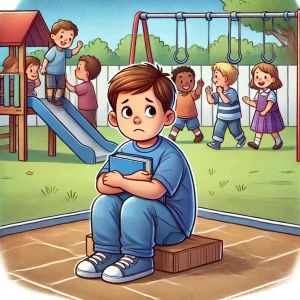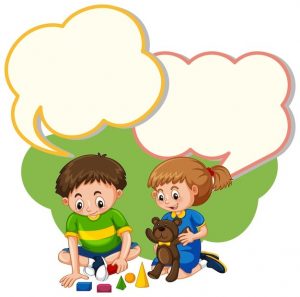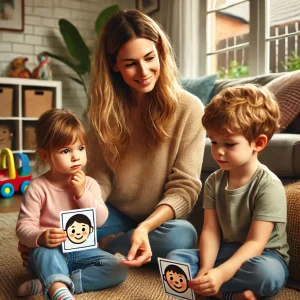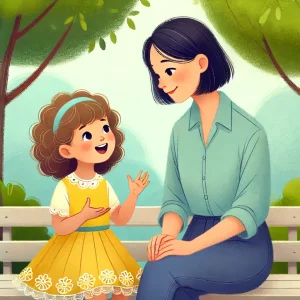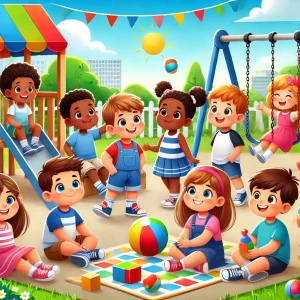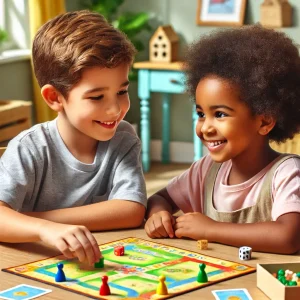What is Social Stories Intervention For Autism?
Last Updated: January 17, 2025
Social Stories for autism are simple, personalized narratives designed to help individuals with autism navigate social situations by explaining what to expect and how to respond. Created by Carol Gray, these stories use clear language and visuals to reduce anxiety, improve communication, and encourage positive behavior. From understanding routines like getting ready for school to managing transitions like visiting the doctor, Social Stories empower individuals to feel more confident and prepared. Whether you’re a parent or educator, creating tailored Social Stories can make a big difference in supporting a child’s growth and social skills.
Explore our expert-crafted Social Stories for Autism and ADHD to support your child’s growth—click here today!
How Do Social Stories Work?
1. The Concept Behind Social Stories
Social Stories simplify everyday social situations by breaking them down into easy-to-understand steps. They work by describing scenarios through storytelling, helping individuals with autism visualize what to expect and how to respond.
For example, a Social Story about greeting someone might say, “When I see a friend, I can smile and say, ‘Hello.’” By providing clear examples, these stories teach appropriate behaviors in a way that feels relatable and non-threatening.
How do they help?
- Clarifying Expectations: Social Stories explain social norms, reducing confusion in interactions.
- Easing Anxiety: By knowing what will happen, individuals feel more confident and less overwhelmed.
- Encouraging Positive Behavior: They guide individuals in handling common scenarios like sharing or waiting patiently.
Key Components of a Social Story
To be effective, a Social Story must include specific elements that make it engaging and easy to understand. Here are the key components:
| Component | Purpose | Example |
|---|---|---|
| Descriptive Sentences | Describe the situation or environment in clear, factual terms. | “I will go to the dentist to have my teeth checked.” |
| Perspective Sentences | Highlight feelings or reactions of others involved. | “The dentist might smile and say, ‘Good job!’” |
| Affirmative Sentences | Reinforce positive outcomes or behaviors. | “It is okay to feel nervous, but I can stay calm.” |
Why are visual aids important?
Including pictures, symbols, or drawings makes Social Stories more engaging, especially for children who are visual learners. Combined with simple, straightforward language, visual aids ensure the story is both accessible and memorable.
Benefits of Social Stories in Autism Therapy
1. Improving Social Skills
One of the most significant benefits of Social Stories is their ability to teach appropriate social behaviors. For individuals with autism, understanding social norms like taking turns, making eye contact, or saying “thank you” can be challenging. Social Stories simplify these concepts by illustrating them in a clear, relatable way.
Example:
- A story about sharing might say, “When I want to play with a toy that someone else is using, I can wait and ask, ‘Can I play when you’re done?’”
By practicing these scenarios through stories, individuals build confidence in real-life interactions.
2. Reducing Anxiety
Unfamiliar or unpredictable situations can be overwhelming, but Social Stories provide a roadmap to ease the unknown. They prepare individuals for new experiences by outlining what to expect, step by step.
How it works:
- A story about a doctor’s visit might include, “I will sit in the waiting room, and when it’s my turn, the doctor will check my ears and throat.”
Knowing what’s coming helps reduce fear and provides a sense of control, making transitions smoother and less stressful.
3. Promoting Self-Confidence
By addressing challenges in a supportive and structured way, Social Stories empower individuals with autism to handle everyday interactions with greater confidence. Success in small tasks—like greeting someone or trying a new activity—builds a positive self-image and encourages independence.
4. Encouragement through Social Stories:
- Affirmative sentences like, “I can do this!” or “I will feel proud when I try my best,” boost self-esteem and create a sense of accomplishment.
The Science Behind Social Stories
Why Are Social Stories Effective?
Social Stories are highly effective because they align with the cognitive strengths of individuals with autism, particularly their preference for structure and predictability. Many people on the autism spectrum find it easier to process information visually and sequentially. Social Stories tap into these strengths by presenting clear, step-by-step guidance paired with visual cues.
Key reasons for their effectiveness:
- Simplified Communication: They break down complex social situations into manageable parts, making them easier to understand.
- Visual and Sequential Learning: By using pictures or illustrations alongside text, Social Stories provide a multi-sensory approach that enhances comprehension.
- Reinforcement of Positive Behaviors: Stories use affirmative language to encourage desirable actions, like, “When I wait for my turn, others feel happy.”
Research and Evidence
Extensive research supports the use of Social Stories as an effective intervention for autism. Studies have consistently shown their positive impact on behavior, communication, and social skills.
Notable findings:
- Behavioral Improvements: Research published in the Journal of Autism and Developmental Disorders highlights how Social Stories reduce challenging behaviors by teaching appropriate responses in specific scenarios.
- Enhanced Social Skills: A study from the International Journal of Special Education revealed that children using Social Stories demonstrated significant improvements in initiating interactions and understanding social cues.
- Increased Independence: Evidence from case studies suggests that Social Stories help individuals handle transitions and daily routines more independently.
Bringing Science to Practice with Wellness Hub
At Wellness Hub, we recognize the importance of evidence-based tools like Social Stories in autism therapy. Our platform offers tailored resources and templates designed to help parents and educators create effective, research-backed Social Stories that address real-life scenarios.
Creating Social Stories for Autism
Steps to Develop a Social Story
Creating an effective Social Story may seem challenging at first, but by breaking the process into simple steps, you can craft stories that are engaging and impactful. Here’s how:
1. Identify the Situation or Behavior to Address
Start by pinpointing a specific scenario or behavior that needs support.
- Examples: Taking turns, visiting the dentist, or staying calm during transitions.
Ask yourself: What does the individual struggle with, and how can the story guide them toward a positive outcome?
2. Write the Story
Use clear and concise language to describe the situation. Remember to keep it relatable and supportive. Include three key sentence types:
- Descriptive Sentences: Explain what is happening.
Example: “At the park, there will be swings, slides, and other kids playing.” - Perspective Sentences: Share others’ feelings or reactions.
Example: “Other kids feel happy when we take turns on the swings.” - Affirmative Sentences: Reinforce positive actions or thoughts.
Example: “I can wait for my turn and feel proud when I share.”
3. Add Visuals
Include pictures, drawings, or symbols to make the story more engaging, especially for younger children or those who learn visually.
4. Test and Refine the Story
Read the story with your child or student and observe their response. If they seem confused or uninterested, tweak the language, visuals, or structure to better fit their needs.
Examples of Social Stories for Autism
Social Stories are versatile tools that can help individuals with autism navigate various situations. Below are examples of how they can be used to address everyday scenarios, social interactions, and coping with emotions.
Everyday Scenarios
Social Stories can make daily routines predictable and less overwhelming. These stories guide individuals through common tasks, helping them build independence and confidence.
Examples:
- Brushing Teeth:
“When it’s time to brush my teeth, I take my toothbrush, put a little toothpaste on it, and gently brush my teeth for two minutes. My teeth will feel clean, and I will have a bright smile!” - Getting Ready for School:
“In the morning, I will put on my clothes, eat breakfast, and pack my bag. I will be ready to learn and have fun at school.” - Waiting in Line:
“When I go to the store, I may need to stand in line. I can wait patiently by standing still and staying calm. Soon, it will be my turn.”
Social Interactions
Understanding how to interact with others can be challenging for individuals with autism. Social Stories provide a safe way to practice these skills.
Examples:
- Greeting Others:
“When I see someone, I can look at their face, smile, and say, ‘Hello!’ They might say ‘Hello’ back, and we can feel happy.” - Making Friends:
“If I want to play with someone, I can say, ‘Can I play with you?’ If they say yes, we can have fun together. If they say no, it’s okay; I can find something else to do.” - Sharing Toys:
“When I play with my toys and someone else wants to play, I can let them have a turn. Sharing makes everyone happy, and we can have fun together.”
Coping with Emotions
Social Stories can help individuals manage their feelings and learn healthy ways to respond to challenges.
Examples:
- Dealing with Frustration:
“Sometimes, I might feel upset if I can’t do something right away. When this happens, I can take a deep breath, ask for help, or try again later.” - Staying Calm:
“If something doesn’t go as planned, I can stay calm by counting to ten or using my quiet voice. Staying calm helps me feel better.” - Asking for Help:
“If I don’t understand something, I can ask for help by saying, ‘Can you help me, please?’ People are happy to help when I ask nicely.”
Conclusion
Social Stories are a simple and effective way to help children with autism navigate social situations, reduce anxiety, and build confidence. By breaking down tasks or interactions into clear steps, they make learning social skills fun and manageable. If you’re a parent or teacher, creating these stories can transform daily routines and interactions. At Wellness Hub, we offer ready-to-use Social Stories templates and resources to make your journey easier. Explore our tools to support your child’s growth and independence.
Frequently Asked Questions:
1. What are Social Stories in autism therapy?
Social Stories are short, simple narratives that teach children with autism how to handle social situations. They use clear language and pictures to explain behaviors and expectations, making social interactions easier to understand.
2. How do Social Stories help children with autism?
Social Stories help children with autism by improving social skills, reducing anxiety, and building confidence. They prepare kids for daily routines, social interactions, and emotional challenges through step-by-step guidance.
3. What are examples of Social Stories?
Examples include stories about brushing teeth, greeting others, waiting in line, or managing emotions like frustration. These stories use real-life scenarios to teach appropriate behaviors and responses.
4. At what age can Social Stories be used?
Social Stories can be used with children of any age, depending on their developmental level. They are especially helpful for younger children and those who struggle with understanding social cues.
5. How do I write a Social Story for my child?
To write a Social Story:
- Identify the situation or behavior to address.
- Use simple language and visuals.
- Include descriptive, perspective, and affirmative sentences.
- Test the story with your child and make adjustments as needed.
6. Can parents create Social Stories at home?
Yes, parents can easily create Social Stories at home with the right guidance and tools. WellnessHub offers templates and resources to help parents craft effective stories tailored to their child’s needs.
7. How are Social Stories different from regular stories?
Social Stories are designed specifically to teach social skills and behaviors. Unlike regular stories, they focus on real-life situations and provide clear examples of how to act or respond.
8. Are Social Stories effective for all children with autism?
Social Stories are highly effective for many children with autism, but success depends on the child’s needs and how the story is presented. They work best when personalized and used consistently.
9. Where can I find Social Story templates?
You can find customizable Social Story templates on WellnessHub. These templates make it easier to create stories for everyday situations and emotional challenges.
10. How often should I use Social Stories with my child?
Use Social Stories regularly, especially before new or challenging situations. Repetition helps children with autism understand and remember the behaviors or routines being taught.
About the Author:
Shravanaveena Gajula
M.Sc ., Speech and Language Pathology (5+ years of experience)
Shravanaveena Gajula is a dedicated Audiologist and Speech-Language Pathologist with a BASLP and an M.Sc in Speech and Language Pathology. With experience spanning multiple settings, including Wellness Hub and Ashray Akruti, Veena specializes in a wide range of disorders from developmental issues in children to speech and language assessments in adults. Her expertise includes parent counseling, managing speech sound and fluency disorders, and creating individualized therapy programs. Veena is also PROMPT certified and an author of several insightful blogs on speech and language pathology, aiming to educate and assist caregivers in supporting their loved ones.
Book your Free Consultation Today
Parent/Caregiver Info:
Client’s Details:
* Error Message
